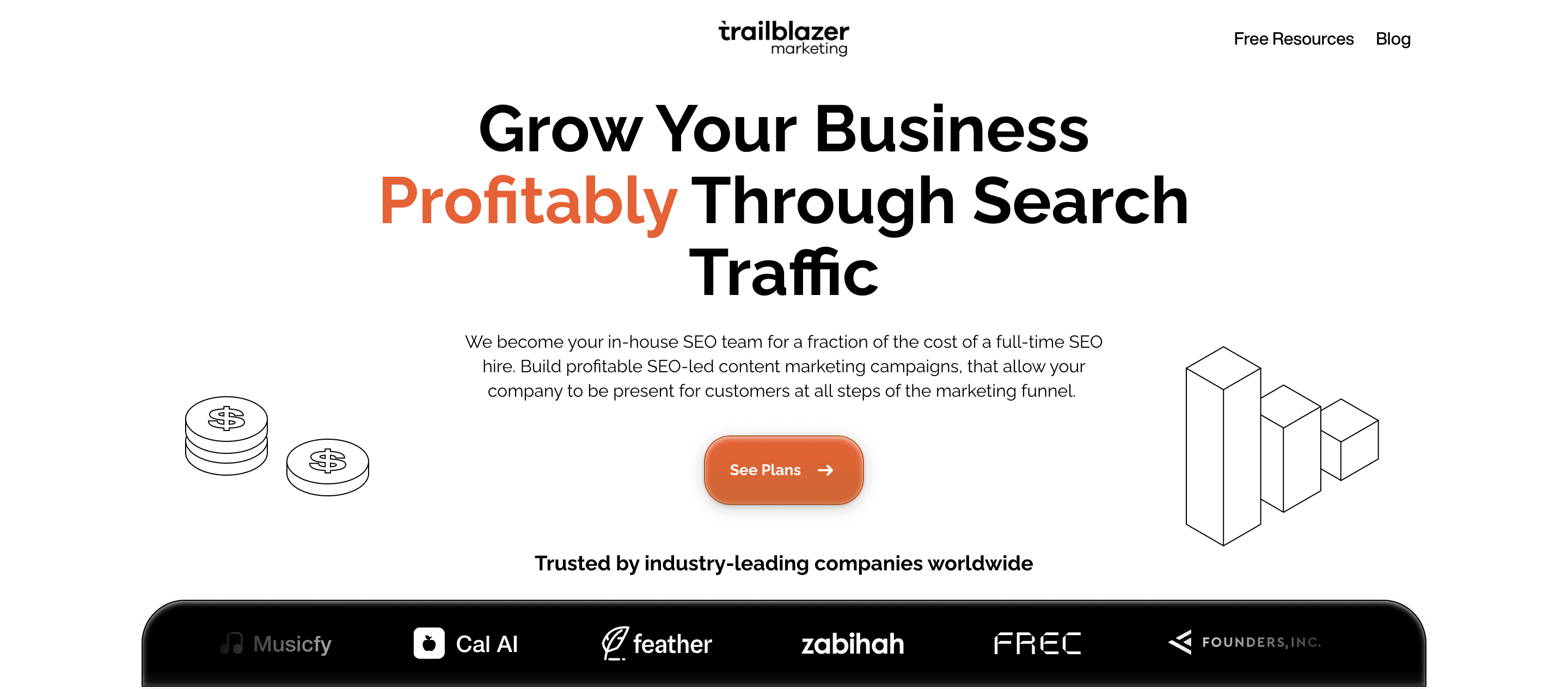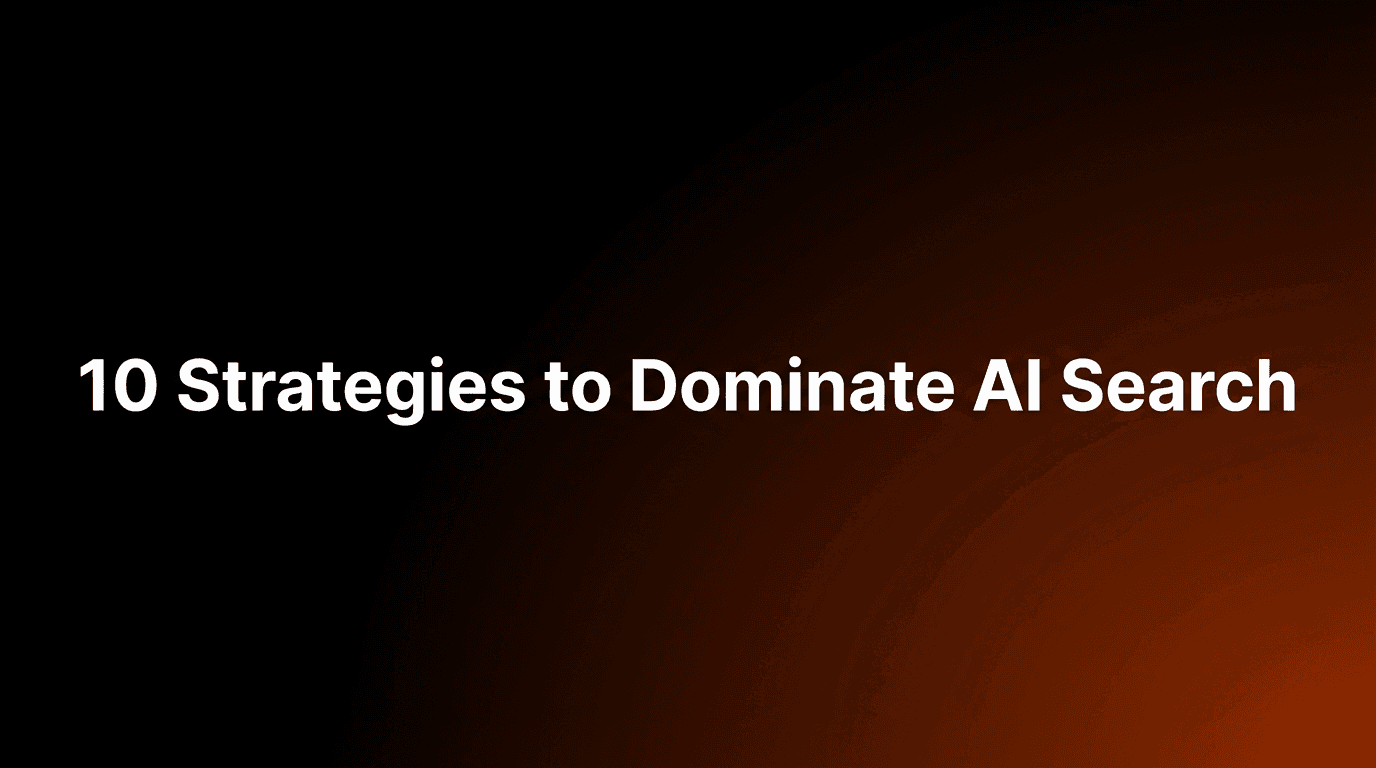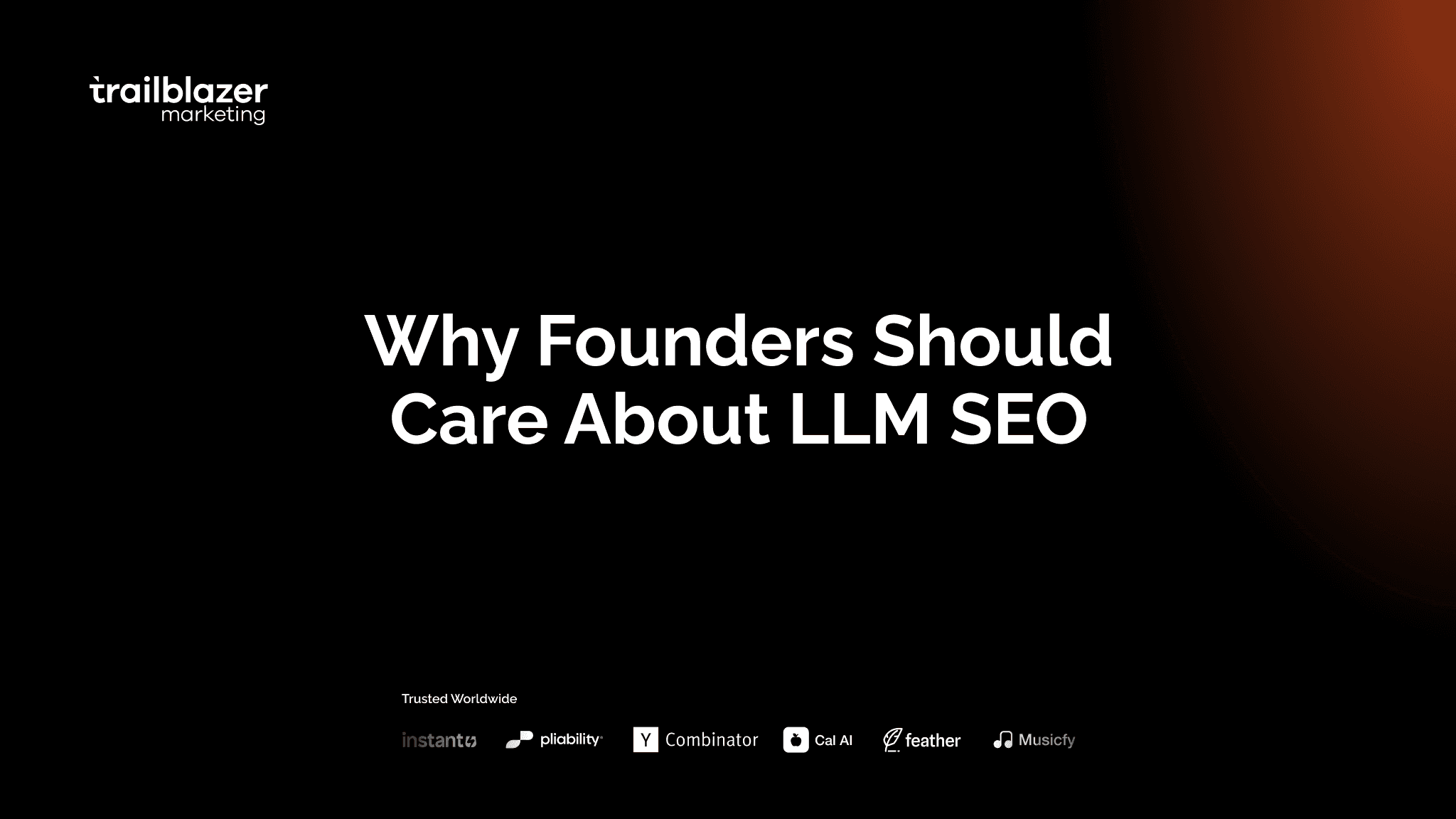How to Adjust Your SaaS SEO Budgets for Competitive Advantage
Mar 28, 2025
Feeling overwhelmed by SaaS SEO? Learn how strategic SaaS SEO Budgets can help you outperform competitors and drive organic growth.
When it comes to demand generation for software as a service (SaaS) companies, search engine optimization (SEO) can seem complex and overwhelming. And to make matters worse, industry competition is fierce, and they're only getting stronger. With so many competitors targeting the same keywords, it can feel impossible for your business to rank on Google. But don't get discouraged with SaaS demand generation. There's a light at the end of the tunnel. By strategically allocating your SaaS SEO budget, you can outperform the competition, drive sustained organic growth, and maximize ROI. This blog will offer valuable insights to help you achieve your goals.
One of the best resources for SaaS SEO is Trailblazer Marketing. We help SaaS companies rank number 1 on Google and AI search. Let us help you achieve your SEO goals so you can get back to doing what you do best—building software.
Table of Contents
Specific Cases Where You Might Shift, Increase, or Re-Allocate Spend on SEO
Validate SEO for $300 - 3 Spots Available per Month | Reserve Your Spot Today
How Much Should You Allocate To SaaS SEO Budgets?

A SaaS SEO budget should typically be 5-10% of total revenue. Some SaaS brands targeting aggressive growth are leaning toward a 10% SEO budget allocation in 2024. Others stick closer to a more conservative 5%. A new startup might spend more on SEO to target faster growth. A mid-size SaaS could have more flexibility to be conservative with its SEO budget since it likely already gets traffic from SEO. According to Model B, early-stage SaaS companies often invest 30% to 50% of their Annual Recurring Revenue (ARR) in marketing efforts, while more established SaaS brands may allocate 10% to 20%.
Budget Range
For most SaaS companies, regardless of stage, you’ll need an SEO budget of at least $2,500-$7,500 per month to see positive ROI from your SEO. The amount your business should spend on SEO depends on a few factors.
In-House Support Vs. Outsourcing to an SEO Agency
Deciding between in-house and agency support will definitely affect how much spend you should allocate to SEO. In-house teams require budgets for salaries, tools, and ongoing training, which can quickly add up. It does give you greater control. Even for an SEO specialist alone, their average salary in the US is $63,905. That’s $5,325 per month. That excludes:
Benefits
Additional expenses
Agency Advantage
With an agency, you’re outsourcing to a team that can completely handle your SEO at a fraction of the cost and headache of managing things internally. On average, most SEO agencies charge around $3,209 per month.
If Paid Advertising is in the Mix
Paid advertising can also heavily influence your SEO budget. PPC budgets tend to be ridiculously high due to the immediate results you get from investing in them. Of course, investing more in paid advertising will limit how much of the marketing budget we can realistically allocate to SEO. There are cases where companies allocate $100,000 per month to PPC while only investing $1,500 in SEO. Despite the substantial difference in budget favoring paid advertising, SEO has outperformed those paid channels.
Lower CAC
In such scenarios, the customer acquisition cost for SEO can be half that of paid. Case studies demonstrate this outcome. When a company invests in PPC, it represents the largest portion of its marketing budget.
If Your GTM and Marketing Strategy is Set
If you feel confident with your go-to-market (GTM) strategy, you can be more confident with your SEO budget. Depending on your GTM strategy, you’ll know how much to budget for SEO and where to spend it without leading to waste. Which topics are specifically relevant to your:
Product
Audience
Avoiding Waste
For startups, your funds are finite. You can’t afford to take a spray-and-pray approach with your SEO. A GTM strategy will keep you aligned on what to target, reducing the chance of wasted SEO spending from changing products or messaging. This outcome has been observed, and it is invariably devastating.
The Audience You’re Going After
If your audience relies heavily on search engines to find solutions, a larger SEO budget might be necessary to capture demand. This also depends on the type of audience you’re targeting. A SaaS company targeting small-to-medium businesses (SMBs) will face different challenges than one going after enterprise clients. SMB-focused SaaS might have a larger audience pool to target, so they will have more flexibility on the type of searches they can target. On the flip side, a SaaS targeting enterprise accounts might need a larger SEO budget to account for the decrease in search volume and likely increase in competition.
Enterprise Budgets
A larger marketing budget overall to target those enterprise accounts. Even still, it’s worth doing customer research before finalizing your budget.
How Aggressive Your Search Competitors Are
A big thing to consider when setting your SEO budget is how aggressive your competitors are. If they’re all aggressively spending on SEO, you’ll have to be just as aggressive, if not more, to catch up to them, especially if they’ve been spending heavily on:
Content
Results from SEO take time, and you won’t overtake your competitors just by publishing 2 articles per month. The best time to start was yesterday. The next best time is today. If you start with a new website, you will be at a complete disadvantage against established sites. You can overcome that disadvantage. But be prepared to spend to do so.
How Aggressive You Want to Be With Your SEO Strategy
SEO budget depends on you and your company’s growth goals. Are you looking to grow only 10-25% in the next few months, or are you aiming to triple traffic? Your overall marketing goals will probably play the biggest part in deciding your SEO budget. But just know, larger ambitions require larger budgets. Don’t expect aggressive results with a conservative budget.
The Different Price Ranges for SEO Investments
A percentage of your revenue is the best strategy for setting your SEO budget. Your budget scales as you grow.
Total Revenue | Recommended SEO Budget (5%) |
$100,000 | $5,000 |
$500,000 | $25,000 |
$1,000,000 | $50,000 |
For a SaaS, you need to have enough budget to prioritise:
Getting high-quality links
Building out quality content at scale
Technical SEO, depending on your site size
Goal Alignment
Your overall goals determine your budget. Regardless of stage, your budget should always align with your growth goals. For startups, this means aggressively spending your SEO budget to build momentum. It’s about balancing SEO with other marketing strategies for established brands to achieve gradual, long-term growth.
How Does Budget Contribute to SaaS SEO?
Your budget is your key to success for SEO. That seems obvious. But, it’s true. SaaS startups with brand new domains have multiple areas to focus on to see success from SEO. It’s not just create content. You have to:
Create extremely high-quality content
Update existing content
Build extremely high-quality links
Make sure your site is optimized for conversions
It’s an expensive play, for sure. If you’re cheap with SEO, you’re throwing your money into the fire. Mid-sized companies may be able to get away with more conservative SEO budgets. Startups don’t have that luxury. You’re at a complete disadvantage starting out. You’re all or nothing for SEO.
Should a SaaS Invest in SEO?
Almost always, yes. Investing in SEO is worth it for most SaaS companies. But not all.
SEO Drawbacks
Some SaaS brands might not benefit from SEO due to:
High competition
Poor product market fit
Lack of resources
Their audience not using search to purchase products
For most SaaS brands, SEO can build a pipeline that becomes a primary driver of growth. It can:
Support long sales cycles without heavy involvement
Generate leads without heavy ad spend
Decrease your overall customer acquisition cost and increase your customer lifetime value
Generate long-term demand and interest in your brand
Scale Back
Even better, SEO allows you to scale back your outbound efforts. With outbound, you’re temporarily renting an audience. You’re building a devoted audience for your brand for inbound and SEO.
The Different Ways I Usually Forecast SaaS SEO
Forecasting is key to SEO budgeting. You need to know your opportunities. And what’s realistic for you. You can forecast your SEO in a few ways.
Keyword-Based Forecasting
This method uses search volume and CTR to estimate traffic from target keywords.
Traffic Estimate: Estimated Monthly Traffic = Search Volume × CTR Leads
Estimate: Estimated Leads = Traffic × Conversion Rate Sales Estimate: Estimated Sales = Leads × Lead-to-Sale
Ratio Revenue Estimate: Revenue = Estimated Sales × Average Revenue Per Customer
Statistical Forecasting with Historical Data
This uses historical trends to predict future growth based on average growth rates.
Growth Rate: Growth Rate = (Current Period – Previous Period) / Previous Period × 100 Traffic
Forecast: Projected Traffic = Current Traffic × (1 + Average Growth Rate)
TAM Analysis
This evaluates the market size and penetration rate to predict traffic potential.
TAM: TAM = Total Audience × % Likely to Search Traffic
Goal: Projected Traffic = TAM × Penetration Rate
These are the main formulas I’ll use when helping clients understand what their opportunities are. And what they should budget for SEO to reach those opportunities.
Applying these Forecasts When Planning Your SEO Budget
When you plan your SEO budget, these forecasts will tell you what opportunities are available. And what SEO budget will likely be necessary for you. While using these SEO forecasts, consider:
Who your SEO competitors are: Who will be the competitors you typically go up against on the SERPs. Sometimes these aren’t even your direct competitors.
How your decision makers usually convert: Is search the last channel they use before they make their final decision? If not, then SEO might be a more difficult channel to execute.
If it’s possible to differentiate yourself from those competitors: Will you be the same as everyone else, or can you stand out?
Execution Level
Once you have a general idea of your SEO landscape and potential, it all comes down to your level of aggression in executing your SEO strategy:
High traffic potential, high competition: You’ll probably have to be more aggressive with your budget
Low traffic potential, high competition: You might consider whether SEO is worth it for your brand.
High traffic potential, low competition: Your budget can be more conservative here.
Low traffic potential, low competition: Is the effort worth the reward?
That’s up to you to decide. There’s no right or wrong answer here. When setting your SEO budget, the biggest takeaway is understanding your landscape and how you want to approach it.
Budgeting for SEO Using Paid Search Traffic as a Reference Point
One way you can think about getting to an actual dollar amount for your SEO budget is to choose a target of how many new signups per month you want through organic traffic, then, based on metrics you have access to, figure out how much that traffic would cost with paid ads. To do this calculation, you need to know your average rates for the following:
Conversion rate from visits to demos (% of site visitors that convert to leads)
Demo closure rate (% of leads that convert to customers)
Cost per click (CPC) through paid search
With these metrics, you can figure out the number of site visitors you’d need to hit my goal for new monthly sign-ups via organic. And then you can multiply that by your average CPC to figure out how much that traffic would cost through paid channels. Let’s say you want 10 new customers per month from SEO.
Conversion Math
If, on average, 5% of site visitors convert to leads, and 10% of leads convert to customers, the math would be: 10 (new signups) / 10% (leads that convert to customers) = 100 (demos per month) 100 (demos per month) / 1% (site visitors that convert to leads) = 10,000 (visitors per month) You’d need 10,000 visitors per month to get your desired 10 new customers per month (We’re just using nice round numbers in this hypothetical to make it easy to follow. Substitute your actual numbers here). Calculate how much these 10,000 monthly visitors would cost you from paid channels.
Paid Benchmark
If your average CPC in Google Ads is $2, then you’d pay $20,000 per month for those clicks through paid. This $20,000 number gives you a benchmark for SEO to meet, then beat. If you can invest that same $20,000 in SEO and get 100 demos and 10 monthly customers, you’ve achieved the results paid channels can get. The advantage of SEO over paid channels is if you can get and keep the rankings that get those 10,000 visitors a month, you can use your budget to get more rankings, and more visitors and, for the same SEO budget, cross the 100 demos and 10 customers numbers above and beat the paid CAC we benchmarked to.
Long-Term ROI
If you can get there, the ROI from SEO will continue to be a better and better investment over time.
Ready to Boost Your SEO? Meet Your New SEO Team.

Trailblazer Marketing serves as your dedicated SEO team, driving profitable growth through strategic content that ranks prominently in both Google and Bing, as well as AI search platforms like:
ChatGPT
Claude
Perplexity
Our scientific approach has delivered extraordinary results across industries. It helps companies rank number one on Google and AI search, including a B2C SaaS client that saw a 3,518% increase in non-branded traffic within just 21 days. Ultimately, this client generated 2.1M organic clicks and over $700,000 in first-year revenue, far exceeding their $300,000 ARR goal.
Proven Results
Similar success stories include a B2B SaaS client achieving 9,644% traffic growth within 10 months and a mobile app seeing a 65 %+ increase in downloads within 50 days. What sets us apart is our comprehensive methodology:
Long-term planning
Product-led keyword research
Competitive analysis
Strategic backlink building
High-velocity content production
Most SEO agencies require thousands per month upfront. Our $300 Validate Program lets you test our process with 10 SEO-optimized articles and see actual results within 30 days before committing to a larger investment. We only have 3 spots available monthly. Reserve yours today.
Related Reading
Specific Cases Where You Might Shift, Increase, or Re-Allocate Spend on SEO

Decreasing your investment in SEO activities rarely makes sense. Competitive markets and the importance of maintaining a strong online presence through organic search make maintaining or increasing your budget the most common path forward. There are a few flags for low growth potential where you might consider shifting your budget to other areas of digital marketing.
When You Might Shift Budget to Another Area of Digital Marketing
1. Spotless Technical Health, High-Performance Content, and Earning Backlinks Naturally
If your technical health is near perfect, you earn backlinks naturally to a wide set of landing pages, and you have high quality content that’s been consistently ranking on the first page of Google for your primary keywords, it’s possible that you could be in a position to shift some of your SEO investment into what is getting you the most impactful result. If PPC generates more signups for you at a low CAC, consider shifting some of your SEO budget.
2. You’re the Dominant Player in Your Space
Suppose you’re like Salesforce or HubSpot, where you’re ranking in position one for your primary topics, and you’re essentially top of mind for anyone searching for related topics in your space. In that case, you might also be in a position where you could divest in some regions of SEO while maintaining high performance. Focus on doubling down on what is delivering results, or shifting budget to improve a lagging area in your digital marketing investments. For most SaaS companies, increasing your budget or reallocating it to bolster your weak points and seize opportunities will make the most sense.
When You Might Increase Your Budget for SEO
1. You’ve Reached the 3:1 LTV-to-CAC Ratio for SEO
Our article on SaaS marketing budgets described Trello founder Joel Spolsky’s “Golden Ratio” of LTV to CAC. If you can achieve a three-to-one ratio of LTV to CAC in a given channel, the money you spend there will continue to produce a positive ROI such that the more you spend, the more profit you’ll make. If your SEO campaign has achieved this ratio, increasing your investment in SEO is likely a safe and effective bet.
2. You Have Mature PPC Campaign Data to Inform SEO
If you’re in a position where you’ve had PPC campaigns running for a while, and you have data showing exactly which keywords convert well, it’s possible that you would benefit from increasing your investment in SEO to target improving your organic rankings for those keywords. As a long-term strategy, getting pages to rank for those terms through SEO could allow you to decrease your PPC spending (costs that would otherwise never go away) while getting the same benefits.
3. SEO Potential is Largely Untapped
If you happen to be in a niche where your competitors have been slow to ramp up their SEO efforts and don’t yet have pages ranking organically for the high-intent keywords in your space, it could be the perfect time to increase the amount of money you’re spending. Very often, the companies that get to this first can continue to reap the benefits of positive ROI for years to come.
Budget Reallocation
Look at when changing the amount of your budget isn’t necessary, but reallocating spend between the three pillars (covered in our article on SEO strategy for SaaS) would improve your results.
When You Might Re-Allocate Spend within the 3 SEO Pillars
1. Compelling Content and Quality Backlinks with Technical Health Issues
Let’s say you’ve been producing high-quality content and successfully building links to it, but you find you have technical problems like:
Sub-optimal site speed
Indexation issues
Consider shifting some of your budgets from content creation to optimizing technical health.
2. Great Content and Technically Healthy with Minimal Backlinks
It may be the case that you’ve focused on producing great content and done so technically soundly. Still, you haven’t built the relationships necessary to foster (or naturally attract) sufficient backlinks. If this is you, you would benefit from shifting your spending to focus on outreach rather than creating more content. In doing so, you could increase the authority of your key pages and overall site, positively impacting rankings.
3. Must-Have SaaS Pages Are Built, But Secondary Content Isn’t Being Leveraged
Suppose you’ve thus far spent your SEO budget building your core website pages such as:
Home page
Product pages
Customer avatar pages, but you’ve yet to develop a content marketing program
In that case, you might shift SEO spend into developing and producing strategic secondary content, such as:
Blog posts
Resources
Content & Links
As you produce compelling content, you can begin doing link building in a way that adds value for your network and works to build your authority simultaneously. More than just these cases can lead you to increase, decrease, or reallocate funds in your SEO budget, these examples should give you direction in parsing out what makes the most sense for your business.
Related Reading
Validate SEO for $300 - 3 Spots Available per Month | Reserve Your Spot Today

SEO is not a short-term strategy. It’s a long-term investment that requires consistent effort over time to deliver substantial results. Many SaaS companies make the mistake of expecting quick results from their SEO strategy. They give up and cut their losses when they don’t get the desired results in a few months. SEO doesn’t work like that. You can see some results quickly, mainly if you target less competitive keywords. But you must stick with it for at least a year to build momentum. HubSpot’s SEO strategy helped them increase organic traffic from 13,000 to over 1 million monthly visitors in just under four years.
Long-Term Vision
While this example is extreme, it shows that you can achieve astronomical results with consistent effort over time. As you’re planning your SaaS SEO budget, remember to think long-term. To improve your chances of success, you’ll need to allocate enough resources to sustain your SEO strategy for at least a year.
Agency Expertise
Trailblazer Marketing serves as your dedicated SEO team, driving profitable growth through strategic content that ranks prominently in both Google and Bing, as well as AI search platforms like:
ChatGPT
Claude
Perplexity
Our scientific approach has delivered extraordinary results across industries. It helps companies rank number one on Google and AI search, including a B2C SaaS client that saw a 3,518% increase in non-branded traffic within just 21 days. Ultimately, this client generated 2.1M organic clicks and over $700,000 in first-year revenue, far exceeding their $300,000 ARR goal.
Proven Results
Similar success stories include a B2B SaaS client achieving 9,644% traffic growth within 10 months and a mobile app seeing a 65 %+ increase in downloads within 50 days. What sets us apart is our comprehensive methodology:
Long-term planning
Product-led keyword research
Competitive analysis
Strategic backlink building
High-velocity content production
Most SEO agencies require thousands per month upfront. Our $300 Validate Program lets you test our process with 10 SEO-optimized articles and see actual results within 30 days before committing to a larger investment. We only have 3 spots available monthly. Reserve yours today.
Related Reading
Dec 11, 2025
The 2025 LLM SEO Playbook: 10 Proven Strategies to Dominate AI Search
This playbook synthesizes the most critical learnings for 2025, moving beyond traditional SEO to a more holistic framework.
Jul 16, 2025
Why Founders Should Care About LLM SEO (Before Everyone Else Does)
LLM SEO is like Google SEO in the early 2000s. This is the biggest organic growth opportunity at the moment. First movers will lead organic growth for the coming decades.
Apr 2, 2025
Rank #1 on Generative AI Search Engine with these Optimization Strategies
AI-driven generative AI SEO. Learn how to create content and GEO strategies for enhanced visibility & personalized results.

Free Resources
Used to help top companies:









